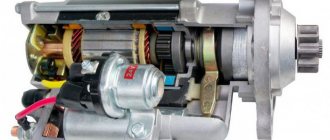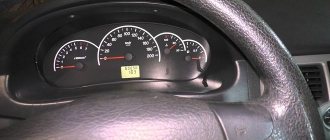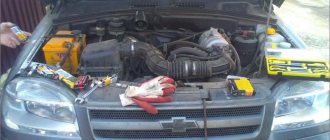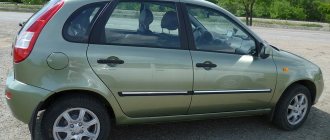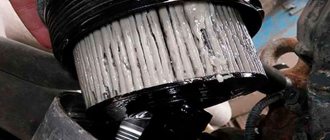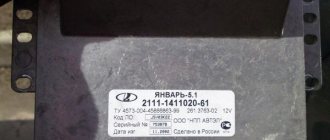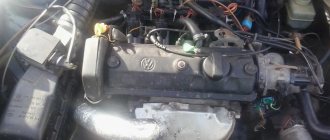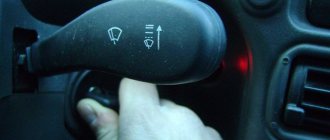The onset of winter cold for many motorists in our country, and not only for the happy owners of products from the domestic automobile industry, is associated with the emergence of a lot of problems of various types. For some, this is the lack of winter tires, a malfunction of the interior heating equipment (stove), and so on.
We will look at the most common malfunction - engine failure to start at temperatures below 10 degrees below zero. There are a great many reasons for this, and we will start with one of the main ones, namely the failure of the fuel injection system to function normally.
VAZ 2114 does not start well. Main reasons and solutions to the problem
For some reason, it seems that many drivers of this model will be intrigued by the question of why the VAZ 2114 does not start well. Finding the cause of this phenomenon is not as easy as it might seem at first. This is due to certain difficulties in finding defects in this model, because injection systems differ from carburetor systems. The method for determining possible problems will be structured differently, adapting to the design features of the machine.
Malfunction of the VAZ 2114 crankshaft sensor is another reason for poor engine starting
Perhaps this is the only sensor without which a VAZ car will not be able to start at all. If, when cranking the engine with the starter and the ignition and fuel supply are working properly, there is no seizure or ignition of the fuel, then the problem is in the DPKV.. It is better to change it. But there is a test method: checking the crankshaft sensor
. Impact of sensors
Most VAZ-2115 cars operate on the “January 5.1” controller. Crankshaft, temperature and throttle sensors are involved in starting the engine.
DPKV malfunctions usually appear regardless of temperature, but it is worth checking its resistance and comparing it with the data in the calibration table.
A more common malfunction is DT. Remove from position and place in a container with a cooler. We measure the resistance with a multimeter: it should be in the region of 1350 - 1880 Ohms. If there is a temperature indicator, the check can be carried out according to the table. If not, that’s not a failure either, just heat it to a random temperature. As T increases, the resistance decreases. With a one hundred percent warmed up engine it is 87 - 109 Ohms. If the ohms do not change or drop to 0, change the DT.
The throttle assembly is completely disassembled and cleaned. One of the problems is dirt, which expands when heated and interferes with the normal operation of the injection. If the TPS is defective, the car not only does not start when hot, but also “does not drive” (from time to time it stalls and does not start) after warming up.
The TPS is checked with an ohmmeter with the engine running. Place the multimeter on the input and output contacts, ask an assistant to press the gas. The readings should change, and at XX return to the initial ones. If the resistance does not change when you press the pedal or the device indicates infinity, the sensor needs to be replaced. We immediately check the IAC. Usually because of it, the car is unstable at idle or stalls, but starts.
A malfunction of the mass air flow sensor on cars with January 5.1 is recognized by the fact that the car starts when hot and immediately stalls. The sensor comes into operation only after start-up. But on a car with January 7.2, the mass air flow sensor is involved in the start - without it the car will not start.
VAZ 2114 starts poorly - no spark
The ignition module is one of the main problems with the VAZ 2114 injector. It often breaks and sometimes a new one comes with a defect. You can read more about checking the ignition module in other material on our website. Please note that the problem may also lie in the chip that is connected to the module. The presence of power on it must also be checked.
DPCV is another reason why there may be no spark. Since this sensor monitors the phases of cylinder operation, it is one of the main parts of the ignition system. Note that the possibility of its failure is lower than that of the ignition module. It is checked by an electrician on an oscilloscope; garage methods do not provide a clear assessment of the condition of the sensor (only replacement with a guaranteed working one).
ECU. “January” is a relatively reliable injector, but the “brains” can also malfunction at times. Often, a problem with them is identified by a violation of the injection phases: for example, a spark is supplied only to cylinders 2 and 4, or only to cylinders 1 and 3. From time to time, the issue is resolved by simply cleaning the contacts on the ECU chip; it is also subject to oxidation, which becomes a prerequisite for loss signal.
The VAZ 2114 car does not start when hot, but when driving everything is fine
The VAZ 2114 car does not start when it’s hot, but when driving everything is fine. And so you can start it with a push. Who knows where to dig. I also changed the spark plugs and wires. I have a video on my page, check it out.
Attention - air
Finally, another possible reason for sudden movements of the needle is the presence of air bubbles in the antifreeze (“airing” of the system). Since the air and antifreeze have different temperatures, the needle jerks. An indirect sign of this malfunction is the splashing of coolant from the radiator cap or expansion tank, as well as a decrease in the filling volume.
PS In order not to upset Logan drivers, on the Duster and the second generation Logan-Sandero the temperature indicator on the dashboard was completely removed. As they say: no pointer, no problem.
Poor starting on a hot VAZ 2114
On a VAZ 2115 it starts perfectly when it’s cool, but when it’s hot when starting it it immediately stalls. Once it cools down, it starts without any problems. What could be the reason?
Poor starting in hot weather is one of the diseases of VAZ cars. Therefore, the question is very common. This happens due to the low quality of spare parts and certain design features. It happens that the fuel pump is replaced with a new one, but it turns out to be faulty. “In search of a malfunction” changes everything in order, and the problem is revealed already on the second round.
If the car does not start when hot, we recommend checking using the following method:
- Point for beginners. Make sure that the problem is related specifically to the “hot” condition of the car. Check the battery charge, make sure that the generator is giving a charge (with a multimeter in voltmeter mode). Are there any problems with the starter? If it sometimes turns, sometimes it doesn’t, or at times it turns poorly, take it to an electrician.
- For everyone else. It’s better to start repairs with diagnostics - it can help save money. Approximately 80% of the circumstances of the problem will be shown by the diagnostician, the faulty part will be replaced, and the car will drive and be fun.
The rest of the information is for the remaining 20% (diagnostics does not reveal problems) and those who do not have trained professionals in the access area.
I have contact
As electricians say, there can only be two faults: there is no contact where needed, or there is contact where it is not needed. This rule also applies in the situation under consideration. The arrow will jump if the joints are oxidized or weakened. Moreover, most often this happens when additional consumers are connected: low beam, headlights, etc.
As mentioned above, the first thing to do when diagnosing DTOZH is to check the contact in the connector. Returning to the previous section, the following should be added: if the sensor malfunctions, the readings fluctuate within the same range, and if they change chaotically, the wiring may be damaged. How important the negative contact is - the mass - will be confirmed by one case described by a forum participant.
The gauge needle sometimes jumped to 130°C. After stopping the engine, it showed the correct result - 90°. The voltage at the battery terminals when the engine was not running was about 12.5 V, and after starting it rose to 13.7.
After a year and a half of unsuccessfully searching for the cause, replacing the battery, alternator and two temperature sensors, I came across one grandpa who installed an additional ground wire from the engine to the body, and the problem was solved.
Hard to start when cold
“It doesn’t start well when it’s cold” - such complaints can be heard from men in cold weather, when discussing cars. If the car does not start well when it is cold, then various symptoms and behavior may be described, but the problems due to which this happens are usually almost similar. The prerequisites for a difficult start differ depending on the type of engine: gasoline (injector, carburetor) or diesel. In this article we will look at the most common cases of such problems as:
Troubleshooting Tips
On gasoline engines, a spark plug can be an indicator that it is difficult to start and stalls when cold. We unscrew it, look: it is flooded - it overflows, we look further along the Fri; dry - lean mixture, we also sort out the options. This method of analysis will allow you to start finding out from the more common ones and gradually approach the more complex reasons for the disgusting start of the engine when cold, rather than finding them in the fuel pump, disassembling the injector, climbing into the timing mechanism, opening the cylinder block, etc.
But with a diesel engine, the first on the list of defects will be weak compression. So owners of diesel cars should pay special attention to it specifically. In second place is the quality of the fuel or its inadequacy for the season, and in third place are glow plugs.
Leaking cylinder head gasket
This problem is one of the rarest causes of engine overheating in VAZ 2114 cars. When it occurs, overheating is a secondary symptom that may be accompanied by a number of others:
- oil leaks from under the cylinder head;
- uneven engine operation and low compression;
- increased oil consumption, noisy engine operation and gas flow, black exhaust.
In this situation, at best, the solution would be to replace the cylinder head gasket. At worst, a major overhaul of the engine with cleaning of all internal cooling channels.
When the engine gets hot, it is dangerous not in itself, but because of its consequences. Long-term driving at elevated operating temperatures first leads to loss of properties of elastic parts: valve stem seals and piston rings. Because of this, oil consumption increases, and engine operation becomes uneven and dirty. All this leads to expensive major repairs.
The consequences of severe overheating are even more severe: the cylinder head and cylinder block are deformed and sometimes crack. An engine that has survived this can no longer be repaired.
Help Friends! car VAZ-2114 1.6 8kl, the problem is that the engine heats up, the fan reaches the red mark and turns on, I wouldn’t pay attention, but it even heats up on the highway if the speed is up to 100 km/h then the temperature stays slightly above 90, and if more than 100 km/h, then the temperature also rises) changing the thermostat did not help). Why does the engine on a VAZ 2114 8-valve injector get hot?
Difficult to start on cold diesel
As is clear, the start of a diesel engine occurs due to temperature and compression, therefore, if there are no problems with the operation of the battery and starter, there may be 3 main ways to find the reason why a diesel engine does not start well during the day when it is cool:
- Missing compression.
- There is no spark plug glow.
- Fuel supply is missing or disrupted.
One of the reasons that a diesel engine does not start when cold, namely, and the disgusting start of a diesel engine in general, is poor compression. If it doesn’t start in the morning, but seizes from the pushrod, and later blue smoke flows for a certain time, then this is 90% low compression.
Checking engine compression
Checking compression in the engine with a compression gauge and without devices with your own hands. How to measure compression in gasoline and diesel engines. Compression diagnostics. More details
A more common case is when the owner of a car with a diesel engine cannot start a cool engine, but a hot one starts without problems - if there is no glow on the spark plugs. They heat diesel fuel until the diesel reaches one hundred percent operating temperature.
There may be three options why candles do not work:
- The spark plugs themselves are faulty;
- It's the spark plug relay. Its operation is regulated by the coolant temperature sensor. During normal operation, the relay makes quiet clicks when the key is turned in the ignition before starting, and if you cannot hear them, then you should find it in the block and check it;
- Oxidation of the glow plug connector. It is not worth explaining here how oxides affect contact.
3 options for checking glow plugs
To check diesel spark plugs, you can choose several methods:
- Measure their resistance (on the unscrewed spark plug) or the open circuit of the heating circuit with a multimeter (checked in the tweeter mode, both screwed into the engine and unscrewing it);
- Check the speed and degree of heating on the battery by connecting it to ground and the central electrode with wires;
- Without unscrewing it from the motor, connect the central wire to the positive terminal of the battery through a 12-volt light bulb.
If the spark plugs are working, and they are properly supplied with power when the ignition is turned on, then in some cases you need to check the valve clearances. Over time, they get lost, and when the internal combustion engine is cool, they don’t lock up one hundred percent, but if you start it and warm it up, they close up and the engine starts normally when it’s hot.
Faulty diesel injectors, as a result of natural wear or contamination (grayish and other impurities), are a more important nuance. In some cases, the injectors throw a lot of fuel into the return line (you need to do a test) or a dirty fuel filter.
Interruptions in the fuel supply cause even more problems starting the engine. So, if the diesel engine does not start in the morning, regardless of the temperature outside, the diesel fuel is leaving (the return valve does not hold), or it is sucking air, other options are the least possible! Air entering the fuel system can cause the diesel engine to have difficulty starting and stalling.
Fuel is out of season or contains foreign impurities. When it’s cold outside and the diesel engine won’t start or immediately stalls after starting, then there may be a problem with the fuel. DT asks for a seasonal switch to “summer”, “winter” and even “arctic” (for especially cool regions) diesel fuel. Diesel does not start in winter because unprepared summer diesel fuel in the cold is converted into a waxed gel in the fuel tank and fuel lines, and also clogs the fuel filter.
In this case, heating the fuel system and replacing the fuel filter helps start the diesel engine. Frozen water on the filter element poses just as many problems. To prevent the accumulation of water in the fuel system, you can add a little alcohol or a special additive to diesel fuel, called a dehydrator, into the tank.
Tips for diesel car owners:
- If, after pouring boiling water on top of the fuel filter, the car starts and works normally, the diesel fuel is summer.
- If there is low pressure in the fuel rail, the injectors may be leaking and not locking (the operation is checked at a special panel).
- If the check shows that the injectors are pouring into the return line, then the needle in the sprayer does not open (they need to be replaced).
Main reasons:
ReasonsCarburetorInjectorDiesel
| Low fuel quality |
| Poor performance of the fuel pump |
| Clogged fuel filter |
| Weak fuel pressure |
| Low fuel level in the carburetor |
| The pressure regulator in the fuel line is faulty |
| Air leak |
| Poor condition of candles |
| Malfunction of high-voltage wires or ignition coils |
| Dirty throttle valve |
| Idle air valve contaminated |
| Malfunction of air sensor characteristics |
| Engine temperature sensor glitch |
| Valve clearances are knocked down or incorrectly set |
| Incorrectly selected oil viscosity (very thick) |
| Low battery charge |
There are also tasks that occur less frequently, but are more significant. We will also mention them below.
Fuel system problems
Among the elements of the fuel accounting system, the following factors influence engine starting:
- presence of gasoline in the tank;
- the integrity of the fuel lines under the “belly” of the car;
- cleanliness of the filters: coarse cleaning (located in the tank) and fine cleaning (located under the car, to the right of the spare wheel compartment).
The carburetor starts poorly on a hot VAZ 2107.
Also included in this category are electrical components that are directly related to the fuel supply. This is an electric fuel pump and a fuel pump relay.
While checking other methods, you need to be completely sure that the VAZ 2114 with an injector is filled. “Yes, there are still five liters there” according to the indicator on the tidy; otherwise, “I filled it up yesterday, I couldn’t spend that much” are not suitable. The gauge may lie, and there may be leaks in the tank or fuel lines. Carefully check the car for fuel leaks; just in case, fill in 5-7 liters of gasoline from a canister.
See:
The mesh in the tank rarely gets clogged, leave this option for last, but it’s worth trying to change the fine filter if electrical problems are ruled out.
The operation of the fuel pump is checked by ear (after turning the key, it is desirable to hear its operation, if not, the pump has “died”, according to another pump relay, as it is also called a broken wiring). According to the manual, you need to connect a pressure gauge to the fuel system. If the pressure does not hold at 2-2.5 atm, the VAZ 2114 does not catch due to insufficient fuel pressure.
Reasons why it is difficult to start when cold
It is important to distinguish between situations in which obstacles arise. The main ones:
- The car is hot and hard to start;
- It starts poorly after being idle, when it cools down (especially in the morning);
- If it refuses to start in cold weather.
They all have their own aspects and prerequisites, which should be considered separately. We will understand in general terms what prerequisites specifically lead to a bad start of a cool engine. Usually one or two rotations of the starter armature shaft is enough to start a car that is in good condition. If this cannot be done, you need to find why.
DTOZh replacement procedure and timing
The procedure for replacing the DTOZh may differ depending on the car model. At the VAZ, to carry out the process, you need to prepare several tools, including the obligatory set of wrenches.
According to the classic scenario, the coolant will have to be drained, otherwise replacing the DTOZH cannot be called correct. Although there are several replacement options that do not involve draining.
As mentioned above, one of the DTOZH is located in the thermostat. It screws in from the side. The second is located a little lower, wrapped in the cylinder head.
A little about the timing of replacement of DTOZH. If we are talking about a regulator that goes to the pointer, then it must be replaced at the very moment when the temperature values go astray. This is easy to check: for example, when the engine is cold, the coolant needle tends to the red zone or simply wanders. This is an error and requires correction, i.e., replacement of the sensor.
In some cases, it also happens that it is not the regulator itself that is to blame, but the wiring or contact. You need to check everything, and only then decide whether to change it or not. Testing the wiring is also easy: the wires are disconnected from the DTOZH, the ignition is turned on and a short to ground is made. If the arrow jumps up, then everything is in order with the wiring.
The second DTOZH changes if the machine itself is not working properly. For example, the speed of a cold engine does not increase, but when it is hot it reaches a value of 1500 rpm. Fault number 2 can also be judged by the cooling fan, which turns on too early or does not do so at all.
Temperature controllers that have been removed are easiest to check. They must be immersed in boiled water heated to certain values, then connect an ohmmeter to measure the resistance coming from the DTOZH.
- Absolutely legal (Article 12.2);
- Hides from photo and video recording;
- Suitable for all cars;
- Works through the cigarette lighter connector;
- Does not cause interference to radios and cell phones.
The injector does not start well when cold
The first thing you should pay attention to if an injection car is not working well is the sensors. Failure of some of them leads to difficulty starting the engine, since incorrect signals are sent to the ECU. It is usually difficult to start when cold due to:
- The cooling water temperature sensor, DTOZH informs the control unit about the state of the coolant, the indicator data influences the start of the engine (unlike a carburetor car), adjusting the composition of the working consistency;
- Throttle sensor;
- Fuel consumption sensor;
- Mass air flow sensor (or MAP, intake manifold pressure sensor).
If everything is in order with the sensors, you first need to pay attention to the following nodes:
- Often there is a problem with starting when cold due to the fault of the fuel pressure regulator. Well, of course, whether it’s an injector or a carburetor, when a cold car doesn’t start well, if it stalls, the speed jumps, but after warming up everything is fine, then the condition of the spark plugs is strictly checked, and the coils and explosive wires are checked with a multimeter.
- Leaking injectors cause a lot of trouble when it’s hot outside, the car will have difficulty starting on a hot engine, and in the cool season a dripping injector will be a prerequisite for difficult starting in the morning. To test this theory, it’s quite easy to release the pressure from the vehicle in the evening so that there is nothing to drip, and look at the result in the morning.
- We cannot exclude such an obvious problem as air leaks in the power system - it complicates starting a cool engine. Also pay attention to the fuel poured into the tank, as its quality greatly affects the starting of the engine.
On cars such as the Audi 80 (with a mechanical injector), we first check the starting injector.
Tips for starting the engine in cold weather
- Keep the tank full - this way condensation will not form and water will not get into the fuel.
- Turning on the high beams for a couple of seconds before starting will restore some of the battery capacity on frosty days.
- After turning the key in the ignition switch (on an injection car), wait a few seconds until normal pressure is created in the fuel system, and then start the engine.
- Pump up gasoline manually (on a carburetor car), but you must not overdo it, otherwise the spark plugs will flood.
- The car runs on gas, under no circumstances should you start it when it’s cold, first switch to gasoline!
Separator design
The VAZ 2114 gasoline vapor separator is a small, completely sealed tank made of metal or impact-resistant plastic. It is installed in the right rear part of the car on a special bracket. Using a hose system, it is connected to the gas tank (from where vapors flow through drain pipes) and to a two-way valve. The total volume of this device is 7 liters.
Location of the separator VAZ 2114Once in this tank, the vapors accumulate in it and, due to increased concentration and cooling, condense. Drops of condensation settle on the walls and bottom, after which they gradually flow back into the gas tank. The same vapors that did not have time to condense flow towards the two-way valve. From its name it is easy to guess that it works in both directions at once - “for the intake” of atmospheric air into the tank and “for the release” of fuel vapors outside.
Despite the obvious simplicity of the fuel ventilation system and the minimum of parts located in it, it still breaks down, leading to rather unpleasant consequences.
So, signs of a vapor separator failure may include:
- smell of fuel inside the cabin;
- the smell of fuel near the car (and a lot of time has passed since refueling);
- gasoline stains near the neck of the tank;
- drops of fuel on the ground after a long stay.
Having noticed these signs, we can conclude that the VAZ 2114 gas tank separator is cracked or leaky and is no longer doing its job.
The carburetor does not start well when cold
Most of the circumstances that the carburetor does not start well when it is cold, or does not start at all, are due to defects in such parts of the ignition system as: spark plugs, explosive wires, coil or battery. Therefore, the first thing that needs to be done is to unscrew the spark plugs - if they are wet, then the electrician is to blame.
The main reasons why the carburetor does not start when cold:
- Ignition coil.
- Switch.
- Distributor (lid or slider).
- Incorrectly configured carburetor.
- The starter membrane or the fuel pump membrane is damaged.
Naturally, if you pump up the gas before starting and pull out the choke more, it will start better. But all these tips are vital when the carburetor is correctly configured and there are no problems with the switch or spark plugs.
Advice from an experienced VAZ 2110 car enthusiast: “When the engine does not start on a cool engine, you need to gently press the accelerator pedal all the way, turn the starter and release the pedal back as soon as it catches, hold the gas in the same position until it warms up.”
Let's look at some common cases when it won't start when cold:
- When the starter turns but does not engage, it means either there is no ignition to the spark plugs, or gasoline is not flowing either;
- If it seizes, but does not start, most likely the ignition or, again, gasoline is faulty;
- If the starter does not turn at all, then there may be problems with the battery.
Why is it difficult to start a cool carburetor?
If everything is normal with oil, spark plugs and wires, then the ignition may be delayed or the starting valve in the carburetor is not adjusted. In general, there may be a torn membrane in the cold start system, and the valve adjustment also says a lot.
To quickly search for the reason for the disgusting start of a cool engine with a carburetor power system, experts advise checking first: spark plugs, high-voltage wires, carburetor starting device, idle jet, and only later also inspect the breaker contacts, ignition timing, operation of the fuel pump and the condition of the vacuum booster tubes .
10 reasons why diesel engines have trouble starting when cold
If a diesel engine is difficult to start when cold, the prerequisites can be collected in a single list of 10 points:
- Starter or battery faulty.
- Missing compression.
- Faulty injector/injectors.
- Incorrect injection timing is set, desynchronization with fuel injection pump operation (timing belt jumps by one tooth).
- Air in fuel.
- The valve clearance is incorrectly set.
- Malfunction of the pre-heating system.
- Additional resistance in the fuel supply system.
- Additional resistance in the exhaust system.
- Internal breakdown of the injection pump.
I hope all of the above will help you, and if it doesn’t solve the problem of starting a cold engine, it will at least point you on the right path to eliminating it on your own or with the help of a specialist.
Why might the engine be difficult to start?
Finding the culprit in such a situation can be done on several fronts. Among them, the most necessary obstacles are:
- Malfunctions in the ignition of a VAZ 2114 car
- There is no pressure in the fuel rail of the 8-cl VAZ engine
- Air leak into the VAZ intake manifold
- Timing belt marks shifted
Checking the spark plug spark
The absence of a spark on one 8-cl spark plug of a VAZ engine does not affect the engine starting, it will be noticeable when idling, tripping and jumping revs. But if the ignition module of the VAZ 2114 is faulty, then sparks are lost in two cylinders 1-4 or 2-3. To check the spark plug spark, take out the fuel pump fuse, unscrew one spark plug or take a spare one, alternately remove the high-voltage wires, put it on the spark plug, then put the whole thing on ground (in this case, the valve cover) and ask a friend to crank the engine with the starter, so we check each spark plug. If there is no spark on one spark plug, there is most likely a fault in the explosive wires, if in two or all spark plugs it can be said with a high probability that there is a problem in the ignition module or the wiring to it.
The timing marks on the VAZ are not set correctly
Another reason why the VAZ 2114 does not start may be a mismatch of timing marks. The reason for the marks to mismatch can be a weak timing belt tension, cut teeth, or crooked mechanic’s hands at 100.
A discrepancy of more than two teeth will noticeably affect the operation of the fourteenth engine. With a small deviation, the engine starts up a little more poorly, does not hold idle, and stalls when switching to neutral gear. If the deviation exceeds 4-5 teeth, the sound of the engine changes, air escaping under pressure through inappropriately open valves becomes audible, traction is noticeably lost, and starting the engine is very problematic.
- To check, we will need a “10” key; use it to unscrew the three bolts securing the timing case.
- Next, put the car in 5th gear and push it until the mark on the camshaft pulley and the rear cover match, you can also turn the pulley with the key to “17”
- We remove the protective plug from the clutch housing and see if the mark on the flywheel matches the mark; if not, then you need to loosen the tension roller and align the belt according to the marks.
Coil
Modern cars are no longer equipped with distributors. There is an ignition module here. VAZ-2115 (16 valves) is no exception. Sometimes breakdowns happen. Because of this, the VAZ-2115 does not start. The reasons are a faulty ignition distributor.
This item cannot be repaired. And in order not to waste time on diagnostics (or if you don’t have a multimeter), it’s worth installing a known-good ignition module. The VAZ-2115 should start without difficulty. Sometimes the high-voltage wires themselves pierce. But in this case the car starts and starts. This can be heard by the characteristic sound of the engine.
Why is the VAZ 2114 8-valve injector difficult to start?
For some reason, it seems that many drivers of this model will be intrigued by the question of why the VAZ 2114 8-valve injector does not start well. Finding the cause of this phenomenon is not as easy as it might seem at first. This is due to certain difficulties in finding defects in this model, because injection systems differ from carburetor systems. The method for determining possible problems will be structured differently, adapting to the design features of the machine.
Let’s try to figure out why the VAZ 2114 8-valve injector doesn’t start well in this work. In a small article, it is impossible to fully discern all possible difficulties; there are some that can only be identified with the help of diagnostic equipment. But, nevertheless, we will try to analyze as many such situations as possible in order to help all VAZ 2114 owners decide what to do in a similar situation.
Engine diagnostics using spark plugs
Let's look at the first option, why the VAZ 2114 doesn't start well. To do this, turn out the candles and look at their color. If there is dark dry carbon on the spark plugs, we can say that the engine has been running for a long time on a rich consistency that coats the spark plugs with black carbon deposits.
Why does dark soot appear on the spark plugs of an injection car:
- Malfunction of the mass air flow sensor
- The 1st oxygen sensor has failed
- Fuel pressure regulator is faulty
- Malfunction of fuel injectors
Snow-white soot on the spark plugs of an injection car occurs due to poor consistency, a prerequisite for the occurrence of:
- Everything is the same as with black soot
- Malfunction of the fuel pump or clogged fuel filter (check the mesh and fine filter)
- Air leaks through the air flow sensor pipe, the place where the XX connection regulator of the manifold is attached.
Checking the crankshaft sensor VAZ 2114
Perhaps this is the only sensor without which a VAZ car will not be able to start at all. If, when cranking the engine with the starter and the ignition and fuel supply are working properly, there is no seizure or ignition of the fuel, then the problem is in the DPKV.. It is better to change it. But there is a test method: checking the crankshaft sensor video
If, after the operations performed, it was not possible to find a breakdown, please write your problem in the comments, I will be happy to answer your question!
Sources:
https://etlib.ru/blog/488-ploho-zavoditsya-na-holodnuyu https://portalvaz.ru/pochemu-ploxo-zavoditsya-vaz-2114-inzhektor-8-klapanov-vy-ne-odinoki/
Electrical problems
If you notice that your VAZ 2114 is difficult to start, then first of all you should check the main electrical components and assemblies that affect its operation.
These include:
- starter;
- spark plug;
- throttle;
- electronic control unit.
In this case, the check should begin with the candles.
If the battery is in perfect order, then you should carefully examine the spark plugs. The presence of oil, carbon deposits, or colored spots on them may indicate that they are faulty. In this case, there are two options for solving the problem - either clean the existing spark plugs (for example, calcinate them or clean them with fine sandpaper and solvent) or replace them with new ones. The last option is the most preferable, since only it will help you find out for sure whether the spark plugs are to blame for the malfunction or not.
If upon inspection it turns out that everything is in order with the spark plugs, then you should check the high-voltage coil. This can be made easier by replacing it with a new, similar one. If the ignition coil (or rather the block) is working properly, then you should proceed to diagnosing the starter.
Checking the starter consists of carefully inspecting it and monitoring the condition of the main elements - the degree of wear of graphite brushes, brass bushings, etc. In addition, you should check the starter using a multimeter (tester), “ringing” it between one of the brushes and the armature. If the tester shows an open circuit, then there is a break in the winding and the part will have to be replaced.
Another reason why the VAZ 2114 does not start well with a cold injector may be a malfunction of the electronic control unit. Checking it at home is extremely problematic, since you will need special diagnostic equipment.
That is why you should either contact a service center to check the ECU or try replacing the unit with another one and try to start the car again. If the car starts right away, then the problem was in the block. In this case, you will have to either buy a new ECU or reflash the existing one (for this you will also need to contact a car service).
What is the reason for shots fired into the silencer?
The reason that the engine shoots into the muffler is usually one - the combustible mixture, which did not have time to burn during the working cycle, explodes inside the intake mechanism as a result of heating to high temperatures. This causes a loud bang.
A similar breakdown can occur on any engine, regardless of the fuel on which they operate and its other parameters. Therefore, both injection and carburetor power plants sometimes shoot.
The cause of such problems is not only a mismatch of valve timing, as many people think.
When the engine starts shooting at the muffler, you immediately need to check the carburetor and air filter. Most often, to eliminate this drawback, it is enough to replace the air filter and adjust the fuel supply to the carburetor. But the reason for the popping may lie elsewhere.
Timing phase violation
If the engine starts firing at the muffler, this may be the result of a failure of the gas distribution phases. The same situation will arise in the combustion chamber as with an ignition delay: the intake valve will open before the combustion of the fuel. The remaining gasoline will burn out inside the exhaust pipe, which will cause shots.
This can also be caused by stretching the timing belt. The phases themselves do not go astray; if the mechanism uses a belt drive, then most likely the reason is the belt stretching.
Does the muffler pop only when the engine is warm, but not when the engine is cold? The problem definitely lies in the timing belt.
Problems with the fuel supply system
Very often the VAZ 2114 8-valve injector does not start well in cold weather due to a malfunction of the fuel system. To check it and identify possible malfunctions, you will have to carry out diagnostics:
- Electric pump.
- Fuel filter.
- Fuel line.
Troubleshooting should begin by inspecting the fuel pump. Checking it is quite simple - when turned on, it should buzz, which will indicate its operation. If no sound is heard, then the pump is faulty and will have to be replaced with a new one of a similar model.
The next common cause is clogging or destruction of the filter. Everything here is also simple - you just need to remove and inspect the filter and, if it is worn out, replace it with a new one.
If the filter, like the fuel pump, turns out to be working, you will have to measure the pressure inside the fuel line (for this, there are both special devices and entire testers that allow you to diagnose the entire fuel system. The simplest version of such a device costs just over 1,000 rubles). If the pressure in the line turns out to be normal, then you should think about other possible reasons.
